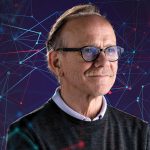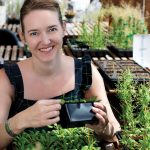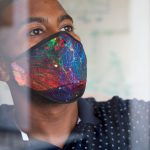In research that aims to illuminate the causes of human developmental disorders, Professor Joseph Ecker, first author Yupeng He, and colleagues have generated 168 new maps of chemical marks on strands of DNA—called methylation—in developing mice. The data can help narrow down regions of the human genome that play roles in diseases such as schizophrenia and Rett syndrome.
Discoveries
New molecule reverses Alzheimer’s-like memory decline
A drug candidate developed by Senior Staff Scientist Pamela Maher and first author Gamze Ates of the Schubert lab, and previously shown to slow aging in brain cells, successfully reversed memory loss in a mouse model of inherited Alzheimer’s disease. The new research also revealed that the drug, CMS121, works by changing how brain cells metabolize fatty molecules known as lipids.
Read News ReleaseSalk scientists discover genetic “dial” to turn immune function up and down to target cancer, autoimmune disease
Associate Professor Ye Zheng, Assistant Professor Diana Hargreaves, co-first authors Jovylyn Gatchalian and Eric Chin-San Loo, and colleagues discovered a way to control regulatory T cells, immune cells that act as a cease-fire signal, telling the immune system when to stand down. Being able to increase or decrease regulatory T cell activity could one day help treat numerous diseases including rheumatoid arthritis, multiple sclerosis, inflammatory bowel disease, lupus and even some cancers.
Read News ReleaseKeeping innocent people out of jail using the science of perception
People wrongfully accused of a crime often wait years—if ever—to be exonerated. Many of these wrongfully accused cases stem from unreliable eyewitness testimony. Now, Professor Thomas Albright, Staff Scientist Sergei Gepshtein and colleagues have identified a new way of presenting a lineup to an eyewitness that could improve the likelihood that the correct suspect is identified and reduce the number of innocent people sentenced to jail.
Imaging method highlights new role for cellular “skeleton” protein
While your skeleton helps your body to move, fine skeleton-like filaments within your cells likewise help cellular structures to move. Now, Staff Scientist Uri Manor and co-first authors Cara Schiavon and Tong Zhang have developed a new imaging method that lets them monitor a small subset of these filaments, called actin. They observed how actin mediates an important function: helping the cellular “power stations” known as mitochondria divide in two. The work could provide a better understanding of mitochondrial dysfunction, which has been linked to cancer, aging and neurodegenerative diseases.
Read News ReleaseLocation, location, location: the cell membrane facilitates RAS protein interactions
Many cancer medications fail to effectively target the most commonly mutated cancer genes in humans, called RAS. Now, Salk Professor Geoffrey Wahl, first author Yao-Cheng (Leo) Li and a team of scientists have uncovered details of how normal RAS interacts with mutated RAS and other proteins in living cells for the first time. The findings could aid in the development of better RAS-targeted cancer therapeutics.
Read News ReleaseFirst immune-evading cells created to treat type 1 diabetes
Professor Ronald Evans, first author and former Staff Scientist Eiji Yoshihara, and colleagues have made a major advance in the pursuit of a safe and effective treatment for type 1 diabetes. Using stem-cell technology, they generated the first human insulin-producing pancreatic cell clusters able to evade the immune system. These “immune shielded” cell clusters controlled blood glucose without immunosuppressive drugs in mice, once transplanted in the body.
Giant leap in diagnosing liver disease
Chronic liver disease represents a major global public health problem affecting an estimated 844 million people. A collaborative team of scientists, co-led by Salk Professor Ronald Evans and including first author Tae Gyu Oh and Senior Staff Scientist Michael Downes, have created a novel diagnostic tool based on the microbiome—a complex collection of microbes that inhabit the gut. The non-invasive method quickly and inexpensively identifies liver fibrosis and cirrhosis over 90 percent of the time and could lead to improved patient care and treatment outcomes.
Read News ReleaseMethod to derive blood vessel cells from skin cells suggests ways to slow aging
Professor and VP/CSO Martin Hetzer, co-first authors Simone Bersini and Roberta Schulte, and colleagues have used skin cells called fibroblasts from young and old patients to successfully create blood vessel cells that retain their molecular markers of age. The team’s approach revealed clues as to why blood vessels tend to become leaky and hardened with age, and lets researchers identify new molecular targets to potentially slow aging in vascular cells.
Read News ReleaseHow targeting killer T cells in the lungs could lead to immunity against respiratory viruses
Salk Professor Susan Kaech examined the immune cells in the lungs, a significant site of damage during the COVID-19 infection. When we are first exposed to bacteria or viruses, immune cells called killer T cells destroy the infected cells to prevent the spread of the disease. Killer T cells effectively provide long-term protective immunity against the invader, a fundamental concept behind vaccination. Kaech’s team, including first author and then-graduate student Jun Siong Low, found that the cells responsible for long-term immunity in the lungs can be activated more easily than previously thought. The insight could aid in the development of universal vaccines for influenza and the novel coronavirus.
How cells solve their identity crisis
Cancer is often the result of DNA mutations or problems with how cells divide, which can lead to cells “forgetting” what type of cell they are or how to function properly. Professor and VP/CSO Martin Hetzer, first author Hyeseon Kang, Assistant Professor Jesse Dixon and colleagues have now provided clarity into how new cells remember their identity after cell division. These memory mechanisms could explicate problems that occur when cell identity is not maintained, such as cancer.
Read News ReleaseCommon diabetes drug reverses inflammation in the liver
The diabetes drug metformin has been prescribed to hundreds of millions of people worldwide as the frontline treatment for type 2 diabetes. Now, Professor Reuben Shaw, first author Jeanine Van Nostrand and colleagues have shown the importance of specific enzymes in the body for metformin’s function. In addition, the new work showed that the same proteins, regulated by metformin, controlled aspects of inflammation in mice, something the drug has not typically been prescribed for. Apart from clarifying how metformin works, the research has relevance for many other inflammatory diseases.
Read News ReleaseTraveling brain waves help detect hard-to-see objects
Professor John Reynolds, Professor Terrence Sejnowski, co-first authors Zac Davis and Lyle Muller, and colleagues have uncovered details about the neural mechanisms underlying the perception of objects. They found that patterns of neural signals, called traveling brain waves, exist in the visual system of the awake brain and are organized to allow the brain to perceive objects that are faint or otherwise difficult to see.
Read News ReleaseFeatured Stories
 Leading Salk science into the futureInside Salk sat down with Rusty Gage to learn more about his background, approach to managing a world-renowned Institute, and vision for Salk science over the next decade.
Leading Salk science into the futureInside Salk sat down with Rusty Gage to learn more about his background, approach to managing a world-renowned Institute, and vision for Salk science over the next decade. Julie Law – Revealing RNAAssociate Professor Julie Law shares common themes underlying her research and discusses what motivates her both in and out of the lab.
Julie Law – Revealing RNAAssociate Professor Julie Law shares common themes underlying her research and discusses what motivates her both in and out of the lab.
 Gerald Pao – Pushing the limits in science and lifeFrom studying the novel coronavirus to downloading brains to computers, Staff Scientist Gerald Pao is at the forefront of scientific advancement.
Gerald Pao – Pushing the limits in science and lifeFrom studying the novel coronavirus to downloading brains to computers, Staff Scientist Gerald Pao is at the forefront of scientific advancement. Austin ColeyAustin Coley, though only at Salk since 2019, has already taken an active role in everything from conducting innovative research on the brain to spearheading a wide variety of outreach activities.
Austin ColeyAustin Coley, though only at Salk since 2019, has already taken an active role in everything from conducting innovative research on the brain to spearheading a wide variety of outreach activities. Salk’s Harnessing Plants Initiative (HPI) Garners Widespread SupportNew grants are supporting the Institute’s efforts to optimize plants’ natural ability to store carbon and mitigate climate change. This support bolsters the ongoing HPI project focused on model plants that was funded through donations to The Audacious Project in 2019.
Salk’s Harnessing Plants Initiative (HPI) Garners Widespread SupportNew grants are supporting the Institute’s efforts to optimize plants’ natural ability to store carbon and mitigate climate change. This support bolsters the ongoing HPI project focused on model plants that was funded through donations to The Audacious Project in 2019.
















































